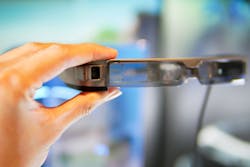Why AR Should be Considered for the ‘New Normal’ Workplace
In a very short period of time, the manufacturing industry has been dramatically impacted by the ‘new normal’ work environment. Even as factories begin to safely reopen, manufacturers must adjust to changing workplace safety needs, implementing new technology and tools to help ensure the health and safety of personnel on factory floors as well as in the field. In light of these circumstances, digital transformation has become a necessity in many industries, with companies expediting the integration of collaboration tools into their day-to-day operations to improve service, repair, and communication.
With fewer people in factories and even fewer people traveling to comply with national and regional safety guidelines, manufacturers are turning to Augmented Reality (AR) technology for remote support and team collaboration. AR has the ability to apply layers of computer-generated information and images onto the user’s view of a physical environment and can be delivered through a hand-held or hands-free device. Unlike hand-held devices such as mobile phones and tablets, coupling AR technology with a hands-free solution such as AR smart glasses, allows factory workers to have situational awareness and keep their hands free for equipment operations and repairs. Additionally, for manufacturing environments with safety requirements, certified protective shields can be paired with, or are already integrated with smart glass devices.
Applications of AR Smart Glasses in Manufacturing
Whether at an automotive manufacturing plant, an offshore environmental remediation site or a field inspection of transmission equipment, AR smart glasses can help streamline a variety of remote assistance and collaboration applications including:
- Streamlined Remote Product Development: The development of products can be a lengthy process that requires numerous back-and-forth communications between several divisions. As companies shift to meet ever-changing safety guidelines, the technology supporting remote collaboration will become critical to sustaining product development timelines. Leveraging cutting-edge augmented reality solutions, not only can collaboration between parties improve, teammates are able to work on the same project from different locations, which ultimately can reduce travel costs.
- Complex Assembly: While assembly instructions for a new product can be made available as a PDF that is printed or displayed on a phone or tablet, these solutions are not optimal for operators to work hands-free. A wearable head mount display (HMD), such as AR smart glasses, allows work instructions to be displayed in the operator’s line of sight with their hands-free to continue working in real-time. In instances where product assembly is especially complex, AR smart glasses can be used for assistance from a remote expert who can discern the issue quickly seeing what the operator sees. After the assessment is made, the remote expert can send files such as images, PDFs, and videos, or make and send annotations that remain locked on the shared screen.
- Remote Workforce Training: In-person manufacturing and technical training and development can be costly when dealing with large, complex pieces of machinery or dangerous equipment with strict safety protocols and guidelines. Using AR smart glasses, manufacturers can connect inexperienced personnel with remote experts to provide real-time visual guidance without the cost and logistics of getting everyone in the same room. With AR smart glasses, factory workers can be trained, informed, and protected in real-time.
- Equipment Installation, Maintenance, and Repair: AR smart glasses allow maintenance crews to connect with remote experts to identify equipment that needs servicing, as well as any potential problems. By “seeing what the maintenance crew sees” in real-time, remote experts can provide the appropriate audio or text instructions, PDF service manuals or tutorial video links to help expedite repairs. Additionally, remote inspectors can see what the on-site team sees before signing off on equipment installations, quality control audits, approving repairs completed, or suggesting corrective action. This eliminates guesswork, reduces the risk of breakdowns, and allows for fast and efficient servicing.
AR Benefits for Today’s Manufacturing Workforce
When a machine suddenly stops working, it can bring factory production to a screeching halt. The equipment downtime coupled with the time it takes for an expert to travel onsite can cost significant amounts of money. With AR remote assistance, operators and technicians can collaborate with remote specialists in real-time, resulting in several benefits.
- Completing Tasks Quickly: In critical downtime, AR remote assistance can allow field personnel to collaborate in real-time with remote experts to complete difficult tasks with fewer mistakes, which can result in reduced execution time and equipment downtime.
- Productivity: In niche manufacturing areas, regional expert resources are limited. With AR remote assistance, experts around the globe can be utilized to provide instruction in the field without the need for costly and time-consuming travel.
- Optimizing ROI: Ultimately, AR remote assistance can allow manufacturers to save money by potentially reducing re-work and travel costs, and ongoing maintenance by getting the job done right the first time to reduce equipment breakdowns.
Almost all industries and sectors have been impacted worldwide and recent projections reveal that manufacturing has undoubtedly been one of the top industries that will be hit the hardest this year. With the workplace landscape continuing to change, now is the time for manufacturers to adopt AR technology to help improve operations. By harnessing the power of AR and remote assistance for resource access, streamlined workforce training, and issue resolution, manufacturers can get ahead of the capabilities gap and build the culture to transition to and exceed in the ‘new normal.’
